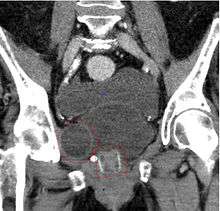Artificial urinary sphincter
An artificial urinary sphincter (AUS) is an implanted device to treat moderate to severe stress urinary incontinence, most commonly in men. The AUS is designed to supplement the function of the natural urinary sphincter that restricts urine flow out of the bladder.
| Artificial urinary sphincter | |
|---|---|
 3D Model of and Artificial Urinary Sphincter | |
| Specialty | urology |
Description

Although models vary, the common thread among currently available designs is a mechanical constriction mechanism placed around the urethra, and an externally accessible control mechanism allowing the user to relieve the constriction to allow urination.[1]
About the artificial urinary sphincter device
Artificial urinary sphincter surgeries have been performed since being first introduced in the early 1970s.[2] The most commonly used device is the AMS 800 (Boston Scientific, Marlborough, MA) (shown in upper right), in which there is a cuff around the urethra, a pump that is placed in the scrotum and an abdominal reservoir.[1] There is fluid inside the system that is used to generate pressure and compress the urethra (to prevent urine from leaking). The urethral cuff is deflated manually by pressing the control pump that is placed in the scrotum, allowing the patient to empty their bladder. The urethral cuff then re-inflates automatically to refill the urethral cuff and once again prevent urine from leaking.[1]
Success rates
Numerous studies have been published regarding outcomes of patients that undergo artificial urinary sphincter placement. In the largest available series, evaluating 1082 patients that underwent AUS placement at Mayo Clinic (Rochester, MN) the 5-year device survival was 74%.[3] Similar results have been reported by others, with 5-year survival rates ranging from 59% to 79%.[4] Along with this, surveys of patients that underwent the procedure have found that over 90% would recommend the procedure to a family member or friend.[5]
Notably, in all series, over time some patients needed to undergo a repeat surgery for recurrent urinary incontinence or device infection. In a pooled analysis of the available studies the re-intervention rate (for any cause) was roughly 26%.[4] Importantly, some studies have demonstrated that surgeons who perform this procedure more frequently (high-volume surgeons) have improved outcomes compared to those who do them less frequently.[6] In fact, in this series the reoperative rates decreased by roughly 50% as surgeons reached their 200th case[6] emphasizing the need for potential patients to seek high volume surgeons to improve their chance of success.
Risks
Possible risks arising from the implantation of the AUS include:
- Injury to the urethra or bladder during AUS placement
- Difficulties emptying the bladder requiring temporary self-catheterization[1]
- Persistent stress urinary incontinence
- Infection of the device leading to removal
- Recurrent incontinence from either device failure or atrophy of the urethral tissues, in which case further surgery can be done to remove the old device and place a new one
Ongoing Cares
As noted above, there is a risk that urinary incontinence returns after AUS placement, in that instance some patients undergo revision surgeries to replace/repair the device and improve their leakage of urine.
For those that have had an AUS placed it is important that they inform their providers prior to any attempt at urethral catheter placement, in an attempt to minimize the risk of damage to their AUS.[7]
References
- Vakalopoulos, Ioannis; Kampantais, Spyridon; Laskaridis, Leonidas; Chachopoulos, Vasileios; Koptsis, Michail; Toutziaris, Chrysovalantis (2012). "New Artificial Urinary Sphincter Devices in the Treatment of Male Iatrogenic Incontinence". Advances in Urology. 2012: 1–6. doi:10.1155/2012/439372. PMC 3332164. PMID 22567002.
- Scott, F. B.; Bradley, W. E.; Timm, G. W. (1974-07-01). "Treatment of urinary incontinence by an implantable prosthetic urinary sphincter". The Journal of Urology. 112 (1): 75–80. doi:10.1016/s0022-5347(17)59647-0. ISSN 0022-5347. PMID 4600662.
- Linder, Brian J.; Rivera, Marcelino E.; Ziegelmann, Matthew J.; Elliott, Daniel S. (2015). "Long-term Outcomes Following Artificial Urinary Sphincter Placement: An Analysis of 1082 Cases at Mayo Clinic". Urology. 86 (3): 602–607. doi:10.1016/j.urology.2015.05.029. PMID 26135815.
- Van der Aa, Frank; Drake, Marcus J.; Kasyan, George R.; Petrolekas, Andreas; Cornu, Jean-Nicolas (2013). "The Artificial Urinary Sphincter After a Quarter of a Century: A Critical Systematic Review of Its Use in Male Non-neurogenic Incontinence". European Urology. 63 (4): 681–689. doi:10.1016/j.eururo.2012.11.034.
- Viers, Boyd R.; Linder, Brian J.; Rivera, Marcelino E.; Rangel, Laureano J.; Ziegelmann, Matthew J.; Elliott, Daniel S. (2016). "Long-Term Quality of Life and Functional Outcomes among Primary and Secondary Artificial Urinary Sphincter Implantations in Men with Stress Urinary Incontinence". The Journal of Urology. 196 (3): 838–843. doi:10.1016/j.juro.2016.03.076. PMID 26997310.
- Sandhu, Jaspreet S.; Maschino, Alexandra C.; Vickers, Andrew J. (2011). "The Surgical Learning Curve for Artificial Urinary Sphincter Procedures Compared to Typical Surgeon Experience". European Urology. 60 (6): 1285–1290. doi:10.1016/j.eururo.2011.05.048. PMC 3646622. PMID 21665357.
- Agarwal, Deepak K; Linder, Brian J; Elliott, Daniel S (2016). "Artificial urinary sphincter urethral erosions: Temporal patterns, management, and incidence of preventable erosions". Indian Journal of Urology. 0 (1): 26–29. doi:10.4103/0970-1591.195758. PMC 5264188. PMID 28197026.